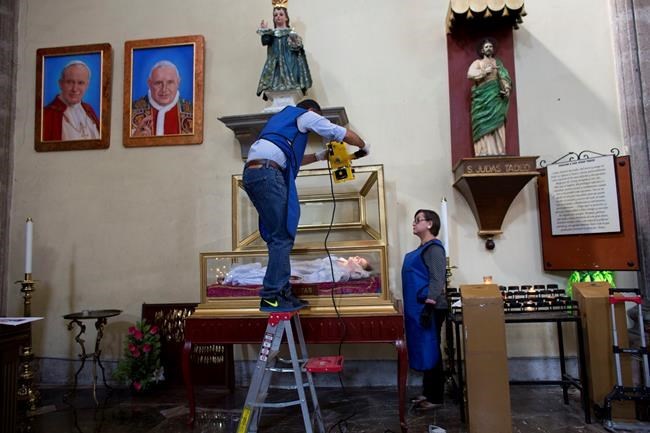
Veterinarian Jose Luis Velazquez, aided by Gabriela Sanchez, a government investigator of historic monuments, takes a high-definition x-ray of a molded wax and cloth figure of Saint Felicitas of Rome, inside its display case at the Metropolitan Cathedral in Mexico City, Friday, July 8, 2016. Non-invasive imaging technology is giving researchers in Mexico their first glimpse at the interiors of centuries-old life-size religious reliquaries representing Catholic saints. X-rays revealed what appeared to be bone fragments inside Saint Felicitas' wax head. (AP Photo/Rebecca Blackwell)
Republished July 08, 2016 - 3:30 PM
Original Publication Date July 08, 2016 - 2:50 PM
MEXICO CITY - High-definition digital X-ray technology is giving researchers in Mexico their first glimpse inside centuries-old reliquaries in the capital's Metropolitan Cathedral.
The reliquaries — containers for holy relics — are life-size, wax body representations of Roman Catholic saints. According to Mexico's National Institute of Anthropology and History, investigators using a portable X-ray machine discovered a cranium, ribs, as well as bones from hands, feet and legs inside the sculpted containers.
"It was almost like they held a secret that only the artist who created the wax figure knew" about, Gabriela Sanchez Reyes of the institute's historic monuments department said on Friday.
Investigators also saw that while the extremities of the reliquaries were made of wax, the torsos were constructed from cloth. The bones contained within them are from saints as well, though not necessarily the same saint that is represented by the sculpture.
Sanchez said the information will allow conservationists to develop preservation and restauration strategies for the reliquaries located in the Mexico City cathedral.
Assisting in the project is Dr. Jose Luis Velazquez, a veterinarian from the National Autonomous University of Mexico. Velazquez used the handheld x-ray machine to collect detailed images of the reliquaries.
"It allows you to see what is not visible while not being invasive," he said.
News from © The Associated Press, 2016